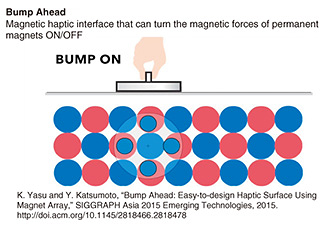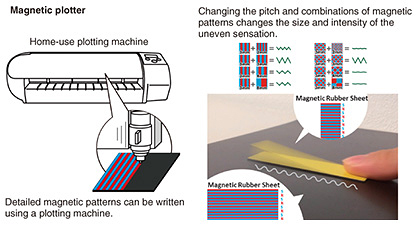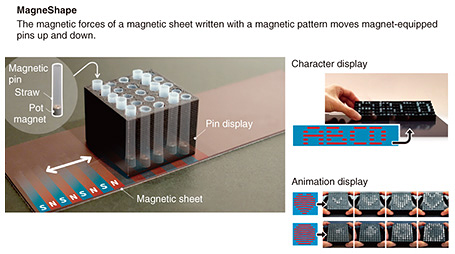 |
|
|
|
|
|
Rising Researchers Vol. 21, No. 7, pp. 13–17, July 2023. https://doi.org/10.53829/ntr202307ri1  Magnetact Technology Based on Magnetic Forces with No Power Supply toward Tactile PresentationAbstractIn the research field of human-computer interaction, various types of studies are underway so that people can use computers in a more comfortable manner. As a part of this effort, NTT is conducting research and development on non-electrical devices to deal with contemporary issues such as the vast consumption of electric power and global warming. In this article, we talked with NTT Distinguished Researcher Kentaro Yasu about Magnetact technology that performs tactile presentation through magnetic forces without the use of electric power. Keywords: Magnetact, magnetic force, tactile presentation Magnetact technology for presenting an uneven sensation using magnetic forces—Dr. Yasu, what exactly is Magnetact technology that you are now researching? Since entering NTT, I have been researching tactile-information presentation technology using magnetic sheets. A magnetic sheet is a commonly sold, very ordinary sheet-shaped magnet. It is a flat object that mixes magnetic material as used in videotape and cassette tape with resin, and as such, it can be written with an S-pole and N-pole magnetic pattern when placed close to a strong magnetic field. Using this property, overlaying and rubbing together two magnetic sheets written with magnetic patterns can generate attractive and repulsive magnetic forces between the sheets. This in turn, can generate a bumpy, uneven sensation between the sheets despite their flatness. We named this technology “Magnetact” as a portmanteau combining the words magnet and tactile. A key feature of Magnetact technology compared with conventional technologies is “no need for electric power.” Before entering NTT, I worked as a research fellow at the National University of Singapore for three years, and during that time, I worked with Yuichiro Katsumoto—now an associate professor at Tokyo Denki University—on “Bump Ahead” technology, which is also being applied to Magnetact technology. In Bump Ahead technology, sliding a device equipped with four magnets across a board laid out alternately with S-pole and N-pole ferrite magnets can generate an extremely strong tactile sensation of unevenness due to attractive and repulsive magnetic forces. In addition, rotating the four magnets built into the device at a 45-degree angle can alter the sum total of the magnetic forces and instantaneously switch between having and not having that tactile sensation (Fig. 1). Before the development of this device, a commonly used technique to achieve this effect was to make a current flow through electromagnets to manipulate magnetic forces, but this was accompanied by a variety of issues such as the large amount of electric power required to produce strong magnetic fields and coil overheating. Against this background, Bump Ahead technology, which can instantaneously turn this tactile sensation ON/OFF simply by rotating magnets without using electromagnets, solved the above issues thereby achieving a major research target.
—How did Magnetact technology that generates an uneven sensation through magnetic forces come to be born? In Bump Ahead technology, major issues remained in the section laid out with ferrite magnets. For example, when laying out ferrite magnets with a diameter of 20 mm and a thickness of 5 mm across an area of 40 × 40 cm, a total of 400 magnets would be needed, and at a weight of about 3 kg, it would be difficult to carry around the device. Furthermore, since those 400 magnets would attract each other while being laid out, even a momentary relaxation could cause a chain reaction in which all of the magnets become stuck to each other. We experienced this failure any number of times when attempting to implement this technology! Thinking that this device in the above form would be difficult to use in real life, we thought about a method that could solve the problems of Bump Ahead technology in an easier way. One day, on going to the laboratory, a neodymium magnet happened to be placed on a magnetic sheet, and on observing this with a sheet called a “magnetic viewer” that had just been adopted for visualizing magnetic fields in research, I noticed that the magnetic fields of the magnetic sheet had been rewritten by the neodymium magnet on top of the sheet. However, the magnetic forces of a magnetic sheet are very weak compared with ferrite magnets, and no sense of unevenness can be felt without rubbing such sheets together. I therefore concluded that this scheme would not be very practical and never took it up for research. Later, though, after entering NTT, I considered that “If the magnetic patterns of such sheets could be easily rewritten, couldn’t the feeling when rubbing them together be predicted by calculations and modified in various ways?” and “Couldn’t a variety of applications become possible by rewriting magnetic fields?” I therefore took up this research again and ended up developing a “magnetic plotter.” A magnetic plotter is a piece of equipment that can rewrite the magnetic fields on a magnetic sheet. I began my research thinking that “If magnetic patterns can be easily rewritten, couldn’t a machine be used to write detailed patterns?” Here, by attaching a compact neodymium magnet to a home-use plotting machine (equipment that can write graphical figures with a pen), I was able to magnetize detailed magnetic patterns on magnetic sheets and use those patterns to control the bumpy, uneven sensation when rubbing two magnetic sheets together. Of course, it is also possible to write a magnetic pattern manually while holding a neodymium magnet in one’s hand, but using a machine enables highly accurate and detailed patterns to be created. As shown in Fig. 2, changing the pitch and combination of written magnetic fields can vary the type of uneven sensation.
Then, in the following year after completing this technology, I conducted research on a technique for creating a haptic interface using this magnetic plotter. This technique takes a magnetic sheet written with a detailed magnetic pattern using the magnetic plotter and pastes it on a touch screen of a tablet or other device to create buttons and switches having a click-type feeling. Whenever presenting the results of this research, I have been reminded of the great potential of haptic technology using magnetic sheets, and I have given this technology in general the name of “Magnetact.” —How are you spreading the word on Magnetact technology to the world? After presenting my research results on Magnetact technology in 2019, I studied methods of getting people in society to use the technology in a variety of formats. In 2020, I held a workshop called “Magnetact Idea Session” together with creators to brainstorm about ways of using Magnetact. Among the various ideas proposed, Masaya Ishikawa, one of the creators representing Japan, proposed the idea of “combining a magnetic sheet with paper to give movement to animal paper craft.” Although Magnetact technology that I proposed presents a tactile sensation through magnetic forces, this idea showed that it was capable of evolving beyond that to the domain of “movement” by connecting a magnetic sheet and cardboard with paper. This idea fulfilled my research theme of “enabling even people with no prior knowledge, experience, facilities, or environment to create something that moves,” which made me quite happy. In a short period after this proposal, Masaya Ishikawa took on a central role in obtaining the cooperation of a specialist in manufacturing paper products (Fukunaga Print Co., Ltd.) and turning this idea into a product called “Magnetact Animals” in 2021. Since then, we have been holding both online and offline workshops at a variety of locations to provide many people with the opportunity of experiencing the wonder of magnets and the joy of creating things that move. In addition, we have recently been developing a technology called “MagneShape.” This technology enables the magnetic forces of a magnetic sheet written with a magnetic pattern to move magnet-equipped pins up and down. It can display characters and animation in a non-electrical manner despite having a very simple configuration (Fig. 3). (See the article in this issue “MagneShape: A Simple Pin-based Shape-changing Display Using Magnetic Materials”)
Creating new ways of making things and delivering value to many people—What is your vision for future research? In human-computer interaction (HCI), my research field, mutual interaction between humans and computers and human-friendly interfaces are common topics of research. Here, my technology, which has no need for a power supply or a machine, appears at first glance to be a technology unrelated to computers. Yet, Magnetact Animals, for example, involves an operation that “designs movement using components pasted to paper shapes or paper,” which makes it very similar to programming using a computer. I believe that magnetic technology typified by Magnetact Animals will play a major role as equipment that can experience and learn the concept of computer operations without actually using a computer. Furthermore, though most computers today run on electric power, the means of achieving output based on numerical calculations, logical operations, and input information is not necessarily restricted to semiconductors and electric current. Indeed, in the outside world, much research is now being conducted on information processing technologies using slime mold and DNA, for example, and on mechanisms for performing calculations based on the physical characteristics of objects and fluids. In the HCI research field, many trials are being proposed on ways of programming shapes, colors, movement, etc. using non-electrical devices called “programmable matter” or “programmable material.” In this regard, wouldn’t magnetic-field-control and information-presentation technologies using magnetic material like what I’m researching here also extend the concept of existing computers and give many people a means of creating things?
—What do you think is an important attitude for a researcher to adopt in research and development activities? In a song that I like titled Ariamaru Tomi by the Japanese singer-songwriter Ringo Sheena, the words “value belongs to and is connected to life itself” appear in a certain verse. If we interpret these lyrics to mean “the strength of human beings is the ability to create something new when something is taken from them,” they become words of encouragement to pursue the creation of something new. By the way, I not only show people things that I myself have created and present them to the world, I also focus on “creating new ways of making things.” I would like many people to create interesting things using new ways of making things. In research, meanwhile, there are many things that demand novelty and freshness, but if one becomes obsessed with cutting-edge tools and materials, the end result may be overly expensive products that cannot be used by anyone or technology that cannot be delivered to the people who really need it. To prevent this from happening, I think it is essential in research to always keep in mind “Who will use this and where?” and “What up to now has not been possible?” In my research, I make it a point to go to DIY (do-it-yourself) stores or supermarkets to check on what types of materials are readily available for ordinary people and to consider whether there are new ways of making things using those materials. I would like to press on with my research without taking my eyes off areas where technology will be needed in the future. —Dr. Yasu, please leave us with a message for researchers, students, and business partners. In the Sensory Interface Research Group of NTT Communication Science Laboratories that I belong to, each member is independently engaged in original research themes. Up to now, I have been conducting research using force-field presentation with magnetic materials based on my own judgment, and I am fortunate to have been able to decide on my own what themes to select, what academic societies to make presentations at, etc. When conducting research within a corporation, the significance of your research from a business perspective and what kind of profits it can generate in the short term are important considerations. At NTT, however, a long-term and strategic perspective is required when deciding on a research theme compared with a short-term perspective directly linked to company profits. This is why I feel that my working environment makes research very worthwhile. Furthermore, in addition to writing papers, I am responsible for preparing patent applications, producing demonstrations and videos, and commercializing my research, but at NTT, I am grateful that I can move my research forward thanks to the support provided in administration, intellectual-property, and commercialization matters and the understanding that I receive from my superiors and colleagues. From here on, as I move forward in my research, my goal is not to present papers but rather to see my research as a starting point. It is certainly true that the number of presented papers has become one index for evaluating researchers, and for students, presenting a certain number of papers is perhaps a requirement for graduation. I, on the other hand, am a person that takes great pleasure first and foremost if someone can make use of the technology that I develop. For this reason, I will continue in my efforts to provide technology in a form that many people can easily use. As reflected by Magnetact Animals, I look forward to those moments in which something that had not occurred to me at all is born. For those of you who would like to try my technology, please feel free to contact me. ■Interviewee profileKentaro Yasu completed his doctoral program in media design at the Graduate School of Keio University in 2013. He worked as a Research Fellow at the National University of Singapore from 2013 to 2016. He entered NTT in 2016 and has been an NTT Distinguished Researcher since 2019. He is currently engaged in the research of tactile-information presentation technology in the field of human-computer interaction. |
|












